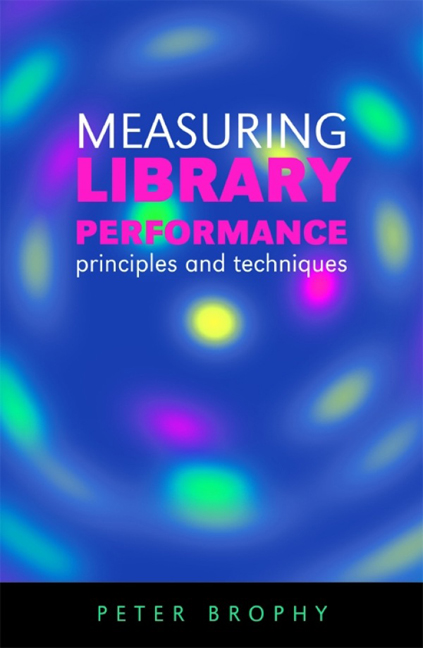Book contents
- Frontmatter
- Contents
- List of figures
- List of tables
- Preface
- Acronyms and abbreviations
- 1 Background
- 2 Theoretical considerations
- 3 User satisfaction
- 4 Impact on users
- 5 Social and economic impact
- 6 Inputs
- 7 Processes
- 8 Outputs
- 9 Staff
- 10 Infrastructure
- 11 Services for all
- 12 Benchmarking
- 13 The balanced scorecard
- 14 Standards
- Appendix 1 Data collection methods
- Appendix 2 The analysis of data
- Appendix 3 The presentation of results
- Index
13 - The balanced scorecard
Published online by Cambridge University Press: 08 June 2018
- Frontmatter
- Contents
- List of figures
- List of tables
- Preface
- Acronyms and abbreviations
- 1 Background
- 2 Theoretical considerations
- 3 User satisfaction
- 4 Impact on users
- 5 Social and economic impact
- 6 Inputs
- 7 Processes
- 8 Outputs
- 9 Staff
- 10 Infrastructure
- 11 Services for all
- 12 Benchmarking
- 13 The balanced scorecard
- 14 Standards
- Appendix 1 Data collection methods
- Appendix 2 The analysis of data
- Appendix 3 The presentation of results
- Index
Summary
■ Introduction
It will be readily apparent from earlier chapters and especially from the description of benchmarking in the last chapter that the performance of a library can only be assessed by examining a range of measures and indicators so as to achieve a balanced view of its various services and operations. This observation brings us back to the issue first raised in the preface, namely that ‘what gets measured gets managed’. The ever present danger of performance measurement is that by focusing attention on particular aspects of service, it will encourage partial and therefore deficient management attention. To achieve a holistic vision and strategy is extremely difficult with social systems such as libraries and information services, where human interactions make measurement and assessment difficult, if not at times impossible. There is always a temptation to make assumptions on the basis of readily available, and thus often quantitative, data rather than on the information that would in fact illuminate the situation, but which is more difficult and more expensive to collect. To try to counter this tendency, management theorists and practitioners have emphasized the need for broad models which are capable of reflecting the complexity of real world organizations acting in complex environments. Thebalanced scorecard is perhaps the best known example, with the widest acceptance. There are a number of other models in use, one of which, the EFQM Excellence Model, was described in Chapter 12, ‘Benchmarking’.
■ Defining the balanced scorecard
Devised initially by Robert Kaplan and David Norton in the USA (Kaplan and Norton, 1992, 1996), the idea of the balanced scorecard was to try to create assessments of organizational performance which took into account all the different relevant factors. In many ways, this development was a reaction to the excessive reliance on financial measures – and in particular the financial ‘bottom line’ – which had dominated industrial and commercial enterprises for many years.
Kaplan and Norton were particularly concerned that financial measures tend to be backwards looking. They may tell us what the business has done in the past, but they do not necessarily tell us where it is going in the future. They also ignore many of the assets of an organization, such as reputation, knowledge, loyal customers and skilled employees.
- Type
- Chapter
- Information
- Measuring Library Performanceprinciples and techniques, pp. 160 - 165Publisher: FacetPrint publication year: 2006



